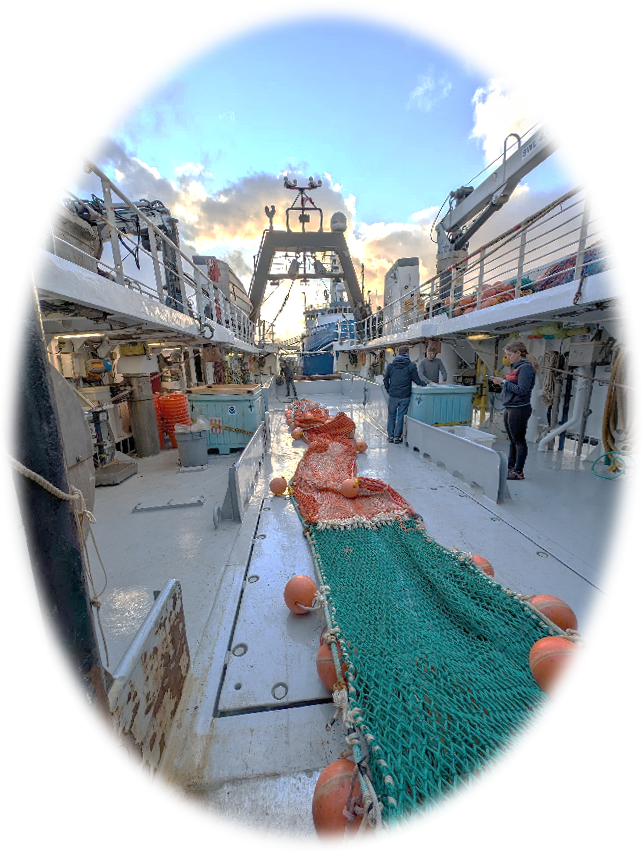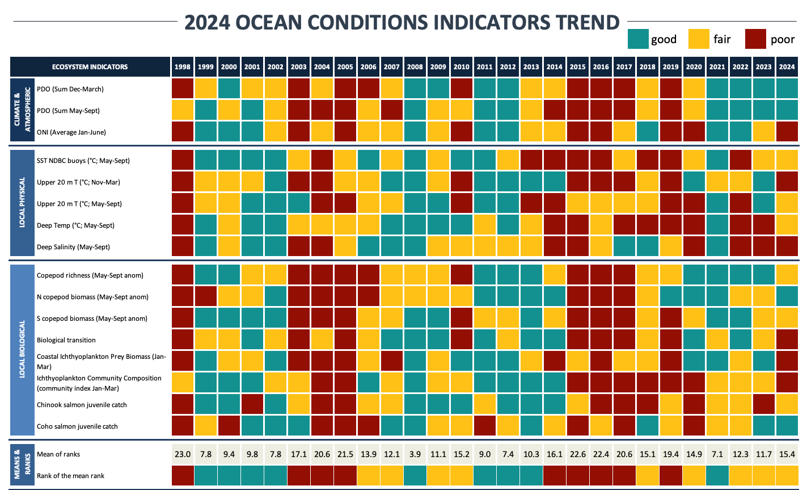Annual update on ocean conditions predicts average adult returns for 2025/2026
- April 18, 2025
- Kym Buzdygon

Brian Burke (Supervisory Research Fishery Biologist, NOAA, Northwest Fisheries Science Center) started the annual update on ocean conditions for salmon and steelhead a little differently than in past years by first highlighting the researchers behind the numbers. The team has a variety of specialists, including field biologists, ecologists, zoologists, modelers, statisticians, physiologists, geneticists, database managers, students, and volunteers.
One of the projects they work on is the Newport Hydrographic Line, funded by NOAA. This project has been collecting important data on ocean conditions experienced by juvenile salmon for almost thirty years. Another big project is the Juvenile Salmon and Ocean Ecosystem Survey, or JSOES, funded by NOAA and the Bonneville Power Administration.
Burke walked the Council through a day in the life of a researcher working on JSOES, starting with bird surveys at sunrise, then moving to plankton and other sampling, and finally hauling the big trawl net- a practice that Burke compared to Christmas morning as researchers never know what they might find. Jellyfish, forage fish like anchovies or sardines, and even small sharks, squids, eels, and more might show up in the net, although it is designed to safely exclude marine mammals. The catch is sorted on deck and everything is counted and measured. Some samples are taken back to the lab for additional data collection like blood samples, fin clips, and stomach contents. This process is then repeated 6-8 times a day. The crew also tracks sightings of dolphins, whales, orca, seabirds, and more.

Ocean conditions
What happens in the ocean is ultimately driven by large scale atmospheric and oceanographic processes. This includes factors like sea surface temperature, sea level pressure, and sea surface height, with indicators like the Pacific Decadal Oscillation (PDO), the Oceanic Niño Index (ONI), and others that represent these broad-scale dynamics. These large-scale indicators historically had more of a correlative relationship with salmon survival. In recent years, those correlations have broken down and are less predictive of survival. However, other data are collected which can help managers understand factors affecting salmon survival. Part of the work Burke’s team does is to try to study the more local biological conditions that impact salmon, like the food web and predation.

NOAA uses the 'Stoplight' chart to show a range of ocean condition indicators that impact salmon, with green representing good conditions, yellow = fair, and red = poor. Burke highlighted the large marine heat wave, known as 'the Blob', which showed up on the chart as lots of red and yellow from 2014 to 2017 or so. The last two or three years have been what Burke called mixed signal years, with a mix of good, fair, and poor indicators likely representing overall average conditions for salmon. It’s hard to know what’s most important, and what’s most important can shift over time, he said. A statistical design chart that further refines the magnitude of these indicators is being developed in partnership with the Pacific Fisheries Management Council.
Burke then shared the forecast of returns, caveating that these are not the same as the forecasts provided at Tuesday’s Council meeting by state and tribal fish and wildlife managers, but meant to be context for how ocean conditions may influence salmon and steelhead returns. However, similarly to those state forecasts, 2025 returns seem on track to be consistent with last year’s numbers, and 2026 returns trending slightly lower.
Growing concerns and potential for future research
Although indicators for 2025 and 2026 are showing mixed signals and average forecasted returns, Burke said that oceans are continuing to warm dramatically and it is likely to worsen. As a result, drivers of growth and survival that have previously been good indicators of salmon returns may no longer be predictive in the same ways. One example is the PDO, as mentioned above, which was highly correlated with ocean conditions and highly correlated with survival of Columbia River stocks. As waters warm, that no longer seems to be the case, making those indicators less useful. He also pointed towards developing a better understanding of other mechanisms, like growth and survival rates and the role of predation.
Burke concluded by emphasizing the important role that this project has played.
“25 years ago, this project was pretty new, and we referred to the ocean as a ‘black box’. Salmon would go in, and a couple years later they come back, and that’s when we would find out what happened. That’s really changed, and we know quite a bit. We know individual stocks, where they’re going, who they’re interacting with, what they’re eating, and to some extent, what’s causing their survival. So it’s important to recognize if we’re not out there, continually studying this changing system, it could revert to a black box. It could become this thing where we no longer understand how things are working and who might be the major players for juvenile salmon.”
The Council’s Columbia River Basin Fish and Wildlife Program recognizes the ocean environment as an integral component of the Columbia River ecosystem. Measures in the Program support monitoring ocean conditions and in-river restoration actions to determine which freshwater actions are of greatest benefit. Ocean condition measures were highlighted in the 2014/2020 Program and Addendum. It is one of the strategy performance indicators found on the Council’s Program Tracker.



